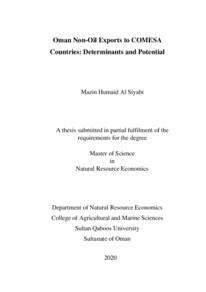Document
Oman non-oil exports to COMESA Countries : determinants and potential.
Identifier
Al-Siyabi, Mazin Humaid (2020). Oman non-oil exports to COMESA Countries : determinants and potential (Master thesis, Sultan Qaboos University, Muscat, Oman).
Publisher
Sultan Qaboos University.
Gregorian
2020
Language
English
English abstract
Since hundreds of years ago, Oman has established trade and cultural linkages with
many African countries in East and South Africa. Omani traders used to ship goods
from Oman to Africa and Omani ports served as a re-export hub taking advantage of
Oman ships infrastructure and logistic connectivity with the main ports at that time.
Over the years, new trade pattern has emerged as Oman diversified its economy and
engaged in global trade within the region and beyond. Despite the fact that Oman
enjoys commercial, historical and cultural ties with many East and South African
countries, yet this strategic relationship has not resulted in boosting trade between
Oman and the countries of the Common Market for Eastern and Southern Africa
(COMESA). This thesis aims to examine the determinants of Oman non-oil exports
to COMESA and investigate Oman export potential. At a country level, the thesis
used a panel data of 21 members countries of COMESA over 2009-2018 and applied
the Poisson Pseudo Maximum Likelihood estimator (PPML) to estimate an
augmented gravity model. At the frim level, the thesis used the probit and logit
models to investigate firms export propensity to COMESA focusing on the role of
innovation and logistics. At the country level, the model shows that Oman GDP per
capita, common language, real effective exchange rate, trading partner logistic
performance LPI have the expected positive effect on Oman exports to COMESA
countries. Distance, trading partner credit risk, applied MFN are found to be negative
as expected. Trading partner GDP per capita is found to be negative, whereas export
credit insurance and innovation have mixed effects on commodity exports. At firm
level, the model found that the firm size and age are not significant in explaining
Oman's export to COMESA. Innovation is positively and significantly correlated
with firm export while as expected the lack of trade facilitation is found to lower
firms exports. The thesis suggested some policy implications at country level and
firm level. At country level, the thesis recommended to reform export credit
insurance scheme, design incentives package for international traders, introduce
incentives to attract innovative companies and to initiate long-term export strategy to
COMESA. At firm level, the thesis suggested that firms should consider innovation
as a routine practice in their business. In the context of COMESA, firms should
adopt innovation that meets the economic characteristics of COMESA.
Member of
Resource URL
Arabic abstract
أقامت سلطنة عمان منذ مئات السنين روابط تجارية وثقافية مع العديد من الدول الافريقية في شرق وجنوب إفريقيا، ونشط التجار العمانيون في شحن البضائع من عمان إلى إفريقيا ومارسوا ما يعرف الان في التجارة الدولية "إعادة التصدير" بفضل البنية التحتية للسفن العمانية والربط اللوجيستي مع موانئ مهمة في ذلك الوقت. وعلى مر السنين، وظهور نمط تجاري جديد، بدأت سلطنة عمان في خطط تنويعها الاقتصادي والانخراط في التجارة الدولية في المنطقة وخارجها. وعلى الرغم من أن سلطنة عمان تتمتع بعالقات تجارية وتاريخية وثقافية مع العديد من دول شرق وجنوب إفريقيا المعروفة الان باسم الكوميسا، الا أن هذه العالقة الاستراتيجية لم تؤد إلى تعزيز التجارة بين عمان والكوميسا بالشكل المطلوب. تبحث هذه الاطروحة في دراسة محددات الصادرات العمانية غير النفطية إلى الكوميسا، وتقصي إمكانات التصدير العمانية على مستوى الدولة، وتستخدم الاطروحة عضًو 2009-2018 من خالل تطبيق النموذج القياسي )PPML .)بيانات تضم 21 ا في الكوميسا خالل الفترة عالوة على ذلك، تستخدم الاطروحة النموذجين القياسيين (Probit (و (Logit (للتحقق من إمكانات التصدير للشركات إلى الكوميسا ومحدداته، وبشكل أكبر حول دور الابتكار واللوجستيات في ذلك. وتظهر نتائج النموذج القياسي على مستوى الدولة أن الناتج المحلي الاجمالي للفرد في ُعمان، واللغة المشتركة، وسعر الصرف الفعلي الحقيقي، والاداء اللوجستي للشريك التجاري LPI جاءت إيجابية حسب المتوقع. كما تبين أن المسافة، ومخاطر ائتمان الشريك التجاري، والرسوم الجمركية للدولة الاولى بالرعاية MFN جاءت سلبية حسب المتوقع. وأظهرت النتائج أن نصيب الفرد من الناتج المحلي الاجمالي للشريك التجاري كان سلبياً، في حين أن ضمان ائتمان الصادرات والابتكار كان لهما نتائج متباينة حسب المنتج. وعلى مستوى الشركات، وجد النموذج أن حجم الشركة وعمرها ليسا ذات أهمية في تفسير صادرات الشركات إلى الكوميسا. الا أن الابتكار يرتبط بشكل إيجابي مع فرص تصدير الشركات، كما أن التحديات المتعلقة بتسهيل التجارة التصدير تؤثر سلبيا على صادرات الشركات وجاءت حسب ما هو متوقع. اقترحت الاطروحة بعض السياسات على مستوى الدولة وعلى مستوى الشركة. فعلى مستوى الدولة، أوصت الاطروحة بإصالح نظام تأمين ائتمان الصادرات، وتصميم حزمة حوافز للتجار الدوليين، وتقديم حوافز لجذب الشركات المبتكرة، وبدء استراتيجية تصدير طويلة الامد إلى دول الكوميسا. وعلى مستوى الشركة، اقترحت الاطروحة ضرورة تنبي الشركات للابتكار ممارسة روتينية في أعمالها. في سياق دول الكوميسا، فإنه يجب على الشركات تبني الابتكار الذي يلبي الخصائص الاقتصادية للكوميسا.
Category
Theses and Dissertations

